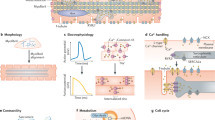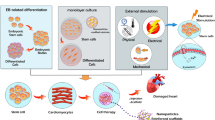Abstract
Debilitating cardiomyocyte loss underlies the progression to heart failure. Although there have been significant advances in treatment, current therapies are intended to improve or preserve heart function rather than regenerate lost myocardium. A major hurdle in implementing a cell-based regenerative therapy is the inefficient differentiation of cardiomyocytes from either endogenous or exogenous stem cell sources. Moreover, cardiomyocytes that develop in human embryonic stem cell (hESC) or human-induced pluripotent stem cell (hIPSC) cultures are comparatively immature, even after prolonged culture, and differences in their calcium handling, ion channel, and force generation properties relative to adult cardiomyocytes raise concerns of improper integration and function after transplantation. Thus, the discovery of natural and novel small molecule synthetic regulators of differentiation and maturation would accelerate the development of stem-cell-based myocardial therapies. Here, we document recent advances in defining natural signaling pathways that direct the multistep cardiomyogenic differentiation program and the development of small molecules that might be used to enhance differentiation as well as the potential characteristics of lead candidates for pharmaceutical stimulation of endogenous myocardial replacement.


Similar content being viewed by others
References
Binah O, Dolnikov K, Sadan O, Shilkrut M, Zeevi-Levin N, Amit M, Danon A, Itskovitz-Eldor J (2007) Functional and developmental properties of human embryonic stem cells-derived cardiomyocytes. J Electrocardiol 40:S192–S196
Boshoff HI, Dowd CS (2007) Chemical genetics: an evolving toolbox for target identification and lead optimization. Prog Drug Res 64(49):51–77
Bushway PJ, Mercola M (2006) High-throughput screening for modulators of stem cell differentiation. Methods Enzymol 414:300–316
Bushway PJ, Mercola M, Price JH (2008) A comparative analysis of standard microtiter plate reading versus imaging in cellular assays. Assay Drug Dev Technol 6:557–567
Campa VM, Gutierrez-Lanza R, Cerignoli F, Diaz-Trelles R, Nelson B, Tsuji T, Barcova M, Jiang W, Mercola M (2008) Notch activates cell cycle reentry and progression in quiescent cardiomyocytes. J Cell Biol 183:129–141
Chen VC, Stull R, Joo D, Cheng X, Keller G (2008) Notch signaling respecifies the hemangioblast to a cardiac fate. Nat Biotechnol 26:1169–1178
Collesi C, Zentilin L, Sinagra G, Giacca M (2008) Notch1 signaling stimulates proliferation of immature cardiomyocytes. J Cell Biol 183:117–128
D’Amour KA, Agulnick AD, Eliazer S, Kelly OG, Kroon E, Baetge EE (2005) Efficient differentiation of human embryonic stem cells to definitive endoderm. Nat Biotechnol 23:1534–1541
Darvas F, Dorman G, Krajcsi P, Puskas LG, Kovari Z, Lorincz Z, Urge L (2004) Recent advances in chemical genomics. Curr Med Chem 11:3119–3145
De Tullio MC, Arrigoni O (2004) (2004) Hopes, disillusions and more hopes from vitamin C. Cell Mol Life Sci 61:209–219
Dinsmore J, Ratliff J, Deacon T, Pakzaban P, Jacoby D, Galpern W, Isacson O (1996) Embryonic stem cells differentiated in vitro as a novel source of cells for transplantation. Cell Transplant 5:131–143
Dolnikov K, Shilkrut M, Zeevi-Levin N, Gerecht-Nir S, Amit M, Danon A, Itskovitz-Eldor J, Binah O (2006) Functional properties of human embryonic stem cell-derived cardiomyocytes: intracellular Ca2+ handling and the role of sarcoplasmic reticulum in the contraction. Stem Cells 24:236–245
Foley AC, Mercola M (2005) Heart induction by Wnt antagonists depends on the homeodomain transcription factor Hex. Genes Dev 19:387–396
Foley AC, Korol O, Timmer AM, Mercola M (2007) Multiple functions of Cerberus cooperate to induce heart downstream of Nodal. Dev Biol 303:57–65
Fransioli J, Bailey B, Gude NA, Cottage CT, Muraski JA, Emmanuel G, Wu W, Alvarez R, Rubio M, Ottolenghi S, Schaefer E, Sussman MA (2008) Evolution of the c-kit-positive cell response to pathological challenge in the myocardium. Stem Cells 26:1315–1324
Gadue P, Huber TL, Paddison PJ, Keller GM (2006) Wnt and TGF-beta signaling are required for the induction of an in vitro model of primitive streak formation using embryonic stem cells. Proc Natl Acad Sci USA 103:16806–16811
Hsieh PC, Segers VF, Davis ME, MacGillivray C, Gannon J, Molkentin JD, Robbins J, Lee RT (2007) Evidence from a genetic fate-mapping study that stem cells refresh adult mammalian cardiomyocytes after injury. Nat Med 13:970–974
Inman GJ, Nicolas FJ, Callahan JF, Harling JD, Gaster LM, Reith AD, Laping NJ, Hill CS (2002) SB-431542 is a potent and specific inhibitor of transforming growth factor-beta superfamily type I activin receptor-like kinase (ALK) receptors ALK4, ALK5, and ALK7. Mol Pharmacol 62:65–74
Kan N, Talantova M, Chen HSV, Mercola M (2008) Selection of cardiomyocytes from differentiating human induced pluripotent stem cells (in review)
Kehat I, Gepstein A, Spira A, Itskovitz-Eldor J, Gepstein L (2002) High-resolution electrophysiological assessment of human embryonic stem cell-derived cardiomyocytes: a novel in vitro model for the study of conduction. Circ Res 91:659–661
Kita-Matsuo H, Barcova M, Prighozhina N, Salomonis N, Wei K, Jacot JG, Nelson B, Spiering S, Haverslag R, Kim C, Talantova M, Terskikh A, McCulloch AD, Price JH, Conklin BR, Chen HSV, Mercola M (2009) Lentiviral vectors and protocols for creation of stable hESC lines for fluorescent tracking and drug resistance selection of cardiomyocytes. PLoS ONE (in press)
Korol O, Gupta RW, Mercola M (2008) A novel activity of the Dickkopf-1 amino terminal domain promotes axial and heart development independently of canonical Wnt inhibition. Dev Biol 324:131–138
Kubo H, Jaleel N, Kumarapeli A, Berretta RM, Bratinov G, Shan X, Wang H, Houser SR, Margulies KB (2008) Increased cardiac myocyte progenitors in failing human hearts. Circulation 118:649–657
Kwon C, Arnold J, Hsiao EC, Taketo MM, Conklin BR, Srivastava D (2007) Canonical Wnt signaling is a positive regulator of mammalian cardiac progenitors. Proc Natl Acad Sci USA 104:10894–10899
Laflamme MA, Gold J, Xu C, Hassanipour M, Rosler E, Police S, Muskheli V, Murry CE (2005) Formation of human myocardium in the rat heart from human embryonic stem cells. Am J Pathol 167:663–671
Laflamme MA, Chen KY, Naumova AV, Muskheli V, Fugate JA, Dupras SK, Reinecke H, Xu C, Hassanipour M, Police S, O’Sullivan C, Collins L, Chen Y, Minami E, Gill EA, Ueno S, Yuan C, Gold J, Murry CE (2007) Cardiomyocytes derived from human embryonic stem cells in pro-survival factors enhance function of infarcted rat hearts. Nat Biotechnol 25:1015–1024
Lindsley RC, Gill JG, Kyba M, Murphy TL, Murphy KM (2006) Canonical Wnt signaling is required for development of embryonic stem cell-derived mesoderm. Development 133:3787–3796
Liu J, Fu JD, Siu CW, Li RA (2007) Functional sarcoplasmic reticulum for calcium handling of human embryonic stem cell-derived cardiomyocytes: insights for driven maturation. Stem Cells 25:3038–3044
Marvin MJ, Di Rocco G, Gardiner A, Bush SM, Lassar AB (2001) Inhibition of Wnt activity induces heart formation from posterior mesoderm. Genes Dev 15:316–327
Naito AT, Shiojima I, Akazawa H, Hidaka K, Morisaki T, Kikuchi A, Komuro I (2006) Developmental stage-specific biphasic roles of Wnt/beta-catenin signaling in cardiomyogenesis and hematopoiesis. Proc Natl Acad Sci USA 103:19812–19817
Olson EN, Schneider MD (2003) Sizing up the heart: development redux in disease. Genes Dev 17:1937–1956
Qyang Y, Martin-Puig S, Chiravuri M, Chen S, Xu H, Bu L, Jiang X, Lin L, Granger A, Moretti A, Caron L, Wu X, Clarke J, Taketo MM, Laugwitz KL, Moon RT, Gruber P, Evans SM, Ding S, Chien KR (2007) The renewal and differentiation of Isl1+ cardiovascular progenitors are controlled by a Wnt/beta-catenin pathway. Cell Stem Cell 1:165–179
Sadek H, Hannack B, Choe E, Wang J, Latif S, Garry MG, Garry DJ, Longgood J, Frantz DE, Olson EN, Hsieh J, Schneider JW (2008) Cardiogenic small molecules that enhance myocardial repair by stem cells. Proc Natl Acad Sci USA 105:6063–6068
Schneider VA, Mercola M (2001) Wnt antagonism initiates cardiogenesis in Xenopus laevis. Genes Dev 15:304–315
Takahashi T, Lord B, Schulze PC, Fryer RM, Sarang SS, Gullans SR, Lee RT (2003) Ascorbic acid enhances differentiation of embryonic stem cells into cardiac myocytes. Circulation 107:1912–1916
Ueno S, Weidinger G, Osugi T, Kohn AD, Golob JL, Pabon L, Reinecke H, Moon RT, Murry CE (2007) Biphasic role for Wnt/beta-catenin signaling in cardiac specification in zebrafish and embryonic stem cells. Proc Natl Acad Sci USA 104:9685–9690
van Laake LW, Passier R, Doevendans PA, Mummery CL (2008) Human embryonic stem cell-derived cardiomyocytes and cardiac repair in rodents. Circ Res 102:1008–1010
Wei ZL, Petukhov PA, Bizik F, Teixeira JC, Mercola M, Volpe EA, Glazer RI, Willson TM, Kozikowski AP (2004) Isoxazolyl-serine-based agonists of peroxisome proliferator-activated receptor: design, synthesis, and effects on cardiomyocyte differentiation. J Am Chem Soc 126:16714–16715
Willems E, Leyns L (2008) Patterning of mouse embryonic stem cell-derived pan-mesoderm by Activin A/Nodal and Bmp4 signaling requires fibroblast growth factor activity. Differentiation 76(7):745–759
Wu X, Ding S, Ding Q, Gray NS, Schultz PG (2004) Small molecules that induce cardiomyogenesis in embryonic stem cells. J Am Chem Soc 126:1590–1591
Xu C, Police S, Rao N, Carpenter MK (2002) Characterization and enrichment of cardiomyocytes derived from human embryonic stem cells. Circ Res 91:501–508
Xu Y, Shi Y, Ding S (2008) A chemical approach to stem-cell biology and regenerative medicine. Nature 453:338–344
Yang L, Soonpaa MH, Adler ED, Roepke TK, Kattman SJ, Kennedy M, Henckaerts E, Bonham K, Abbott GW, Linden RM, Field LJ, Keller GM (2008) Human cardiovascular progenitor cells develop from a KDR+ embryonic-stem-cell-derived population. Nature 453:524–528
Yasunaga M, Tada S, Torikai-Nishikawa S, Nakano Y, Okada M, Jakt LM, Nishikawa S, Chiba T, Era T, Nishikawa S (2005) Induction and monitoring of definitive and visceral endoderm differentiation of mouse ES cells. Nat Biotechnol 23:1542–1550
Zhang Q, Major MB, Takanashi S, Camp ND, Nishiya N, Peters EC, Ginsberg MH, Jian X, Randazzo PA, Schultz PG, Moon RT, Ding S (2007) Small-molecule synergist of the Wnt/beta-catenin signaling pathway. Proc Natl Acad Sci USA 104:7444–7448
Acknowledgments
Our research cited in this review was conducted in collaboration with the laboratories of Dr. Marcia I. Dawson (Burnham Institute), Dr. John Cashman (Human Biomolecular Research Institute), Dr. Clemencia Pinilla, and Dr. Richard Houghten (Torrey Pines Institute for Molecular Studies) and supported by research grants from the NIH/NHLBI and California Institute for Regenerative Medicine. This work was funded by grant support from the California Institute for Regenerative Medicine (CIRM) (RC1-00132-1), the NIH National Heart, Lung and Blood Institute (R37HL059502, R33HL088266), and Mather’s Charitable Foundation to MM and CIRM fellowship (T2-00004) to EW.
Author information
Authors and Affiliations
Corresponding author
Rights and permissions
About this article
Cite this article
Willems, E., Bushway, P.J. & Mercola, M. Natural and Synthetic Regulators of Embryonic Stem Cell Cardiogenesis. Pediatr Cardiol 30, 635–642 (2009). https://doi.org/10.1007/s00246-009-9409-2
Received:
Accepted:
Published:
Issue Date:
DOI: https://doi.org/10.1007/s00246-009-9409-2




